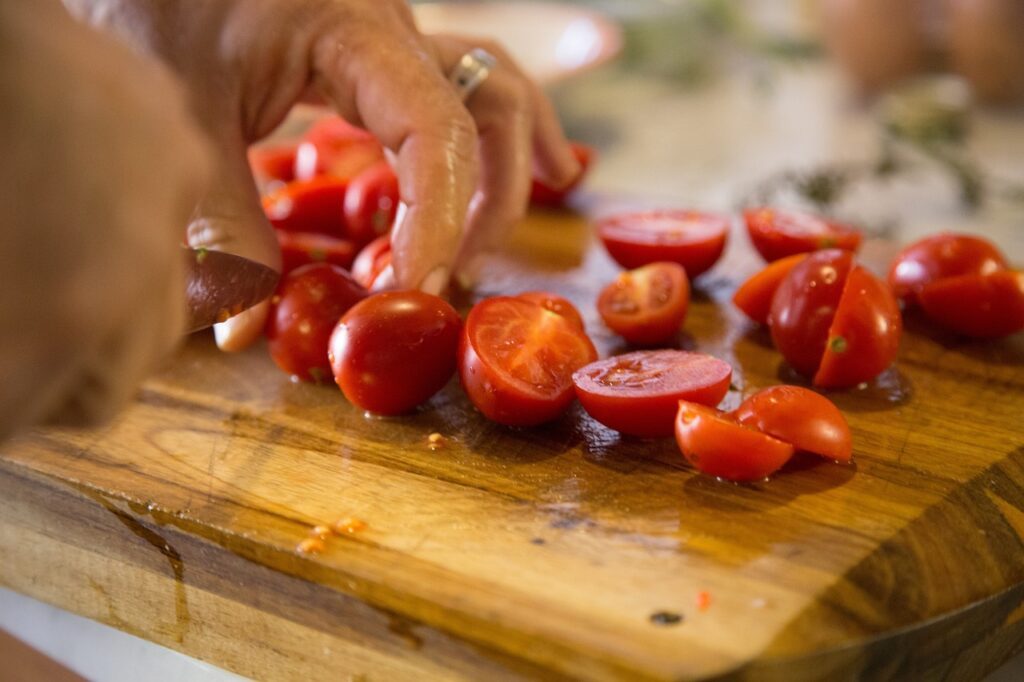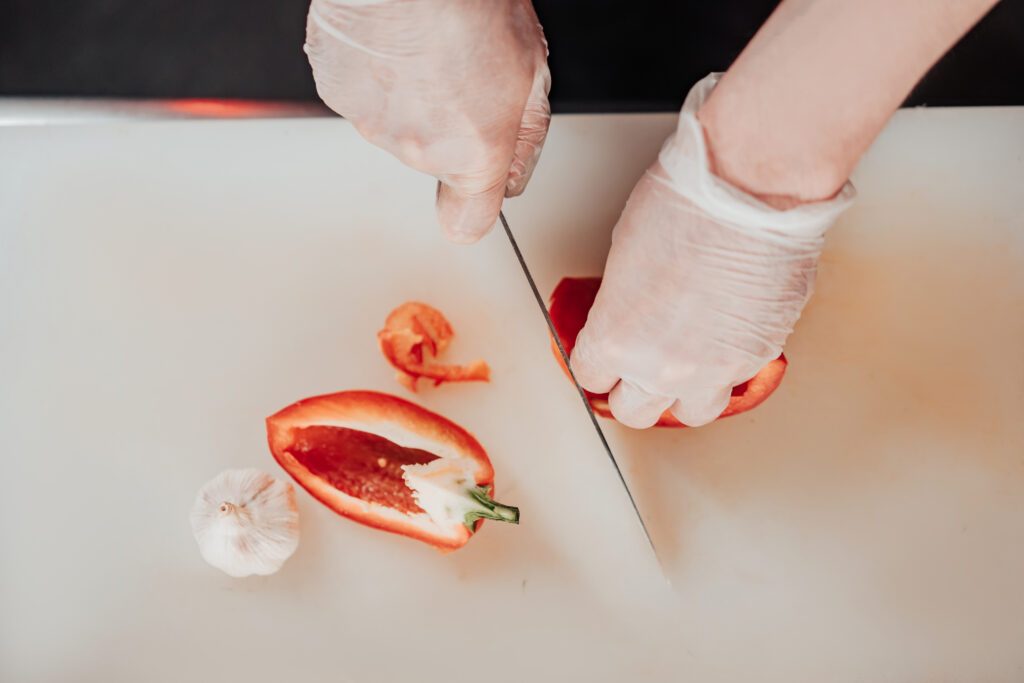
Best Cutting Board Materials: Pros and Cons
Cutting boards are more than just flat surfaces; they are the silent allies of chefs and home cooks worldwide. From the initial prep work of chopping fresh produce to delicately dicing rare ingredients, cutting boards lay the groundwork for culinary masterpieces. It’s not an overstatement to say that a kitchen without a cutting board is like a painter without a canvas. Moreover, the right cutting board can substantially reduce the risk of cross-contamination, ensuring that the dishes we prepare are not only delicious but also safe.
As we venture into the realm of cutting boards, it’s essential to note the vast array of materials at our disposal. The selection isn’t just about aesthetics or cost; it’s about functionality, maintenance, longevity, and, importantly, the impact on our knives. From traditional hardwoods to modern plastics, and from elegant stone to sustainable bamboo, each material has its own set of merits and limitations.
Wooden Cutting Boards

Advantages:
- Gentle on Knife Blades: One of the hallmarks of wooden cutting boards is their gentleness on knife edges. Unlike materials that can be hard and abrasive, wooden cutting boards, especially those crafted from hardwoods, provide a kind surface that doesn’t quickly dull knives. This characteristic ensures that chefs can maintain the sharpness of their knives for more extended periods.
- Antimicrobial Properties: An often underappreciated aspect of wooden boards is their inherent antimicrobial properties. While it might seem counterintuitive, certain woods can naturally combat bacteria, ensuring a safer food preparation surface. This isn’t to say that they’re entirely resistant to bacterial contamination, but their self-cleaning nature is a significant advantage.
- Aesthetically Pleasing: Beyond functionality, the visual appeal of wooden boards is undeniable. The warm tones, rustic charm, and unique grain patterns make them not only efficient cutting surfaces but also beautiful kitchen showpieces. This dual functionality allows them to be used for both cooking and serving, adding a touch of elegance to the dining experience.
- Eco-Friendly Choice: Wooden boards are also an environmentally-conscious choice. Being biodegradable, they don’t contribute to landfills like plastic boards. Additionally, sourcing wood sustainably has a lower carbon footprint compared to the production of plastic or glass boards. The longevity of wooden boards also means reduced consumption and waste in the long run, making them an eco-friendly option for the kitchen.
Disadvantages:
- Requires Regular Maintenance: The beauty and efficiency of wooden boards come at a cost: maintenance. These boards need regular oiling and care to maintain their luster, prevent cracking, and keep them hygienic. Without this TLC, wooden boards can deteriorate faster than their counterparts. Read more about how to maintain your wooden cutting board.
- Potential for Moisture Absorption: One inherent property of wood is its porous nature. As such, wooden boards have the potential to absorb liquids. If not properly dried and stored, this can lead to issues like warping, bacterial growth, and unpleasant odors.
- Can be Expensive: Quality often comes with a price. High-quality wooden boards, especially those made from exotic or rare woods, can carry a hefty price tag. While they offer numerous advantages, the initial investment might be a deterrent for some, especially when compared to more affordable alternatives in the market.
Plastic Cutting Boards

Advantages:
- Easy to Clean: Plastic cutting boards boast a non-porous surface, making them relatively simple to clean. A swipe with some soap and water usually does the trick. Their resistance to moisture absorption means they don’t house bacteria as readily as some porous materials, ensuring a more hygienic food prep surface.
- Lightweight and Versatile: Unlike some of their heavier counterparts, plastic cutting boards are usually lightweight, making them easy to maneuver around the kitchen. Their versatility extends to various shapes, sizes, and colors, allowing users to select ones that fit specific needs or even to color-code boards for different food groups to avoid cross-contamination.
- Often More Affordable: Price is a significant factor in many kitchen-related decisions, and here, plastic boards shine. They tend to be more wallet-friendly than boards made from materials like high-quality wood or stone, making them an accessible choice for many households.
Disadvantages:
- Impact on knives sharpness: The impact of plastic cutting boards on the sharpness of knives is a crucial aspect to consider. The hard surface of these boards can cause the knives to dull more quickly, leading to frequent need for sharpening and potentially reducing the overall lifespan of the knives. This issue is particularly important for those who value the longevity and effectiveness of their kitchen knives. Check out our in depth analysis.
- Susceptibility to Deep Scratches: While plastic boards are sturdy, they aren’t immune to wear and tear. Over time, knives can leave deep scratches, which can harbor bacteria if not thoroughly cleaned. This can pose a hygiene concern.
- Environmental Concerns: In today’s eco-conscious world, the environmental impact of our choices is paramount. Plastic, being non-biodegradable, poses concerns regarding its long-term effect on the environment, especially when discarded. Many are advocating for the use of more sustainable materials in kitchens and elsewhere.
- Potential Warping Under High Heat: Plastic boards aren’t the best friends of high heat. If exposed to extreme temperatures, like being inadvertently placed on a hot stove or in a dishwasher’s high-heat cycle, they can warp, affecting their flatness and usability. This requires users to be more cautious with their storage and cleaning methods.

Stone and Glass Cutting Boards

Advantages:
- Sleek and Modern Appearance: One of the undeniable attractions of stone and glass cutting boards is their visual appeal. They provide a contemporary, polished look that many modern kitchens covet. Whether it’s a translucent glass board or a marbled granite one, they add a touch of elegance to any countertop.
- Non-porous Surface: Stone and glass surfaces are non-porous, meaning they won’t absorb liquids, flavors, or colors from the foods you’re preparing. This makes them an excellent choice for pungent foods like onions and garlic.
- Easy to Clean: With their smooth surfaces, stone and glass boards are a breeze to clean. A simple wipe down with a damp cloth or sponge, followed by a thorough drying, will often suffice. Their resistance to staining ensures they maintain their pristine appearance over time.
Disadvantages:
- Can Dull Knife Blades Quickly: The hard nature of stone and glass is not always kind to knives. Continued use on these surfaces can quickly dull blade edges, demanding more frequent sharpening. This concern is a common topic among chefs.
- Breakable and Heavy: Glass and some stone materials, especially those like marble or slate, can be quite fragile. Dropping them or accidentally hitting them with force can lead to chipping or breaking. Additionally, their weight can make them cumbersome to move around the kitchen or store away.
- Lack of Natural Antimicrobial Properties: Unlike some woods which have inherent antimicrobial properties, stone and glass lack this natural defense against bacteria. Although their non-porous nature reduces the risk of bacterial growth, it’s still essential to clean and disinfect them regularly to ensure safe food preparation.
Bamboo and Other Eco-friendly Materials

Advantages:
- Sustainable and Environmentally Friendly: Bamboo is one of the fastest-growing plants on Earth, making it an eco-friendly resource. It requires no chemicals and very little water to grow, and it releases more oxygen into the atmosphere compared to other plants. Its sustainability is frequently discussed and celebrated.
- Durable and Lightweight: Bamboo boards offer a resilience comparable to many hardwoods, making them ideal for frequent use in the kitchen. Yet, despite their durability, they are surprisingly lightweight, ensuring ease of use and mobility during food preparation.
- Resistant to Deep Scratches: Unlike plastic, bamboo doesn’t scar as easily from knife cuts. This resistance to deep scratches reduces the crevices where bacteria can hide, promoting a more hygienic surface for cutting and chopping.
Disadvantages:
- Requires Occasional Oiling: Bamboo boards can dry out over time, especially if frequently washed or exposed to dry air. To maintain their appearance and prevent cracking, they require periodic oiling with food-grade mineral oil or bamboo conditioning oils. Check out how to oil your bamboo board.
- Can Absorb Flavors if Not Treated: As with many wooden boards, untreated bamboo can absorb flavors and odors from pungent foods like garlic or onions. Proper treatment and cleaning can mitigate this, but it’s a factor to consider if planning to use the board for a variety of foods.
- Might Not Be as Long-lasting as Hardwoods: While bamboo is durable, it may not stand the test of time as effectively as some hardwoods. The natural fibers in bamboo can become frayed or split after years of heavy use, potentially shortening its lifespan compared to boards made of maple or walnut.
The Rise of Silicone cutting boards
In the ever-evolving world of kitchenware, the rise of silicone cutting boards marks a significant shift in culinary preferences and practices. Let’s explore the growing popularity of these innovative tools, focusing on their advantages over traditional materials like wood, plastic, and bamboo. Key aspects such as hygiene, durability, environmental impact, and consumer trends are examined to understand this shift. Market analyses highlight silicone’s increasing application in various sectors, including kitchen products, underscoring its unique benefits and driving its rise in popularity.
Conclusion
In the quest to identify the best cutting board material, it’s evident that each material offers distinct advantages and drawbacks. Wooden boards, with their natural charm, are gentle on knife blades and boast antimicrobial traits, but their need for consistent upkeep and potential heftier price tag can’t be ignored. Meanwhile, the convenience, cost-effectiveness, and versatility of plastic boards are overshadowed by their susceptibility to deep scratches and overarching environmental implications. The sleek elegance of stone and glass boards is undeniable, as is their straightforward cleaning process. Yet, their tendency to dull knives and inherent fragility can deter many. Bamboo and other eco-friendly materials emerge as champions in the sustainability arena, coupled with impressive durability. However, they might demand more maintenance and may not always match the longevity of some hardwoods.
But beyond these technicalities, the selection of an ideal cutting board hinges profoundly on individual needs and preferences. It’s not solely about the material’s attributes but also how it aligns with your kitchen’s ambiance, your maintenance willingness, budget, and eco-conscious choices. Ultimately, your cutting board should not just fulfill culinary functions but should echo your unique lifestyle and culinary enthusiasm. Choosing thoughtfully means investing in a tool that seamlessly integrates into your kitchen narrative, enhancing every meal preparation experience.







